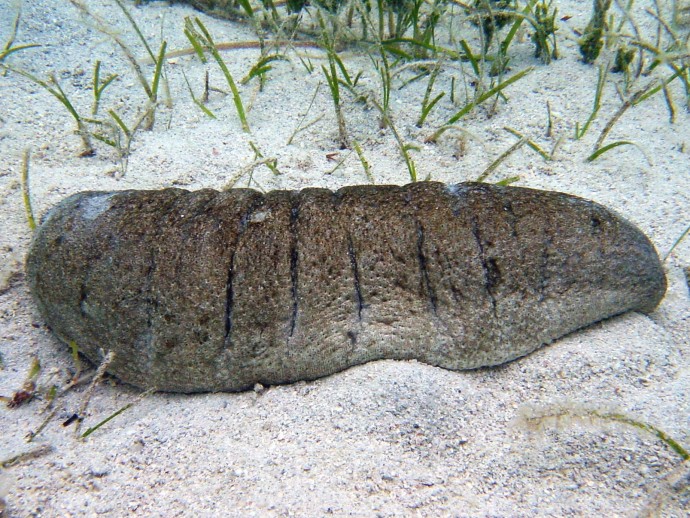By Valeli J. Bugota and Cyrus Rumisha
Summary
Sandfish (Holothuroids) or sea cucumbers in general play important ecological roles in the ecosystem. One role is remineralising large quantities of organic nutrients through their feeding and burying activities, which increases the benthic productivity of coral reefs. Further, the role of sea cucumbers in the dissolution of CaCO3 sediment provides an important source of alkalinity and may play a role in buffering ocean acidification at least at local scales on coral reefs.
The tropical sandfish Holothuria (Metriatyla) scabra Jaeger, 1833 has been severely depleted in the Western Indian Ocean because it is easy to catch and in high demand. In response, Mainland Tanzania closed the fishery; however, the fishery remains open in the semi-autonomous islands of Zanzibar. Yet, it is unknown whether the aforementioned contrasting management measures are consistent with the genetic stock structure of the fishery. Therefore, this study analysed partial sequences (706 base pairs) of the cytochrome oxidase subunit I gene (COI) from four sandfish populations from Tanzania to assess the extent of genetic diversity and population structure. The populations showed low haplotype (0.17–0.44) and nucleotide diversities (0.025–0.084%), as well as small mutation-scaled effective size (9 × 10−4−17 × 10−4) compared to other marine macroinvertebrates from Tanzania, suggesting that the fishery has not recovered despite the ban that was imposed 16 years ago. Furthermore, Analysis of Molecular Variance (AMOVA) revealed a low and non-significant genetic differentiation index (FST = 0.0047, p > 0.05), indicating a lack of population structure. The lack of population structure was further supported by phylogenetic analysis, which grouped together all COI haplotypes of sandfishes from both Zanzibar and Mainland Tanzania. This suggests that populations in Mainland Tanzania and Zanzibar are genetically homogeneous and that Zanzibari fishers may be targeting the same stock that is protected in Mainland Tanzania. Therefore, the fishery should be managed as a single unit, and management measures between Mainland Tanzania and Zanzibar should be harmonized.
Introduction
The sandfish Holothuria (Metriatyla) scabra Jaeger, 1833 (Echinodermata: Holothuroidea) is a tropical sea cucumber with a wide Indo-Pacific distribution that stretches from east Africa to the eastern Pacific (Tuwo et al. 2019). The sandfish is sedentary and often shows high abundance in shallow muddy and sandy-muddy areas among seagrass beds, particularly those adjacent to mangrove and coral reef ecosystems (Rahantoknam et al. 2021). The sandfish is a seasonal spawner with two spawning periods in July and August and December and January (Kithakeni and Ndaro 2002). Fertilized eggs hatch into larvae within 36 h after spawning, and the larvae remain planktonic in water for about 16–17 days, swimming with the help of tiny cilia until they metamorphose into sedentary juveniles (Mercier et al. 2000; Al Rashdi et al. 2012). Due to the long planktonic larval duration, the sandfish H. scabra has the ability to disperse over great distances, facilitating recruitment to various habitats in its natural range. Dispersal is not limited to the pelagic larval phase, but may also occur during the benthic juvenile/adult stages through active buoyancy adjustment (Hamel et al. 2019).
The sandfish H. scabra is the most valuable and commercially important sea cucumber, ranking probably number one on the world bêche-de-mer market (Conand 2008). Because of their slow rates of movement and easy access to fishers, they have been overfished all over the world to feed the demand for bêche-de-mer in Asia (Uthicke and Conand 2005). Consequently, populations of H. scabra are estimated to have declined by at least 50% in the past 30–50 years (Hamel et al. 2013). The decline has had a negative impact on the income and livelihoods of communities that rely on the sandfish fishery, particularly in developing countries (Conand 2008). In response, management strategies have been developed over the last three decades to sustainably promote development, maintenance, or regeneration of wild sandfish (Riquet et al. 2022). In Mainland Tanzania, a total closure of the fishery was implemented in 2006, which is still in effect today (URT 2009). The country also banned the sale and export of H. scabra and its products, including bêche-de-mer in accordance with Regulations 13 (11) and 67 (2) of the Fisheries (Amendment) Regulations, 2009 (URT 2009). However, because the ban was imposed without dialogue with the semi-autonomous Zanzibar Islands (Mmbaga 2015), the fishery remains open in Zanzibar. As a result, there is a potential that Zanzibari fishers are targeting the same stock that is protected in Mainland Tanzania, especially if sandfish populations from these areas constitute a single stock. If this is the case, it may compromise management efforts made by Mainland Tanzania, rendering the ban ineffective and threatening the fishery’s sustainability despite enacted measures (Árnason et al. 2009). Such consequences were observed in the Atlantic cod (Gadus morhua), which continued to decline despite enacted measures because management approaches were not consistent with the population genetic structure of the fishery (Zemeckis et al. 2014). Thus, a comprehensive analysis of the genetic structure of the sandfish populations in Tanzania is required to inform the decision-makers on whether the current management approach is in line with the fishery’s genetic stock structure. Therefore, the aim of this study was to assess the extent of genetic diversity and structure among populations of the sandfish H. scabra along the Tanzanian coast. The results of this study could help Tanzanian policymakers and decision-makers make well-informed decisions about sandfish management and conservation.
For more details: Click here
Bugota, V.J. and Rumisha, C. (2023). Low genetic diversity and lack of genetic structure among populations of the sandfish Holothuria (Metriatyla) scabra on the Tanzanian coast, Marine Biology Research, DOI: 10.1080/17451000.2023.2176883
Share this page




